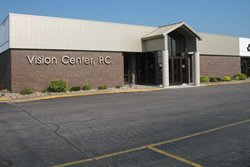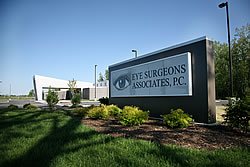Many Advanced Technology Options are available to reduce or eliminate your need for glasses by remedying your astigmatism, nearsightedness, farsightedness, and presbyopia – all reasons patients need glasses.
See your options at cataracthelp.com .
Blended Vision
With Blended Vision, the surgeon corrects one eye for distance vision and aims for intermediate focus (computer screen, sheet music, shopping or kitchen counter, etc) for the second eye. Many contact lens wearers and former LASIK surgery patients are familiar with this concept. It trades away some distance and depth perception to provide the near help. In most circumstances, the brain merges the two images without the patients’ awareness, so for those without astigmatism, many daily activities can be done without glasses.
Patients occasionally wear prescription glasses to improve their sharpest vision at any distance, but especially for reading the fine print. Additional testing, which is not covered by insurance or Medicare, is required to best calculate whether you are a reasonable candidate for Blended Vision.
Astigmatism
If you have significant cataracts and astigmatism and desire to see clearly at ANY distance without glasses, you require Advanced Technology Refractive Vision Correction. Astigmatism means the shape of the clear cornea is curved in such a way that unless corrected, the vision remains distorted or blurred.
Our surgeons select the optimal astigmatism correction technique most appropriate for your needs (laser astigmatism correction, Toric IOL, or some combination of the two). Patients with Advanced Technology Astigmatism Correction typically enjoy excellent vision at one distance, but may still need glasses for other distances. Although, a Blended Vision strategy may be chosen once they decide upon Advanced Technology Astigmatism Correction.
Learn about specific lenses at cataracthelp.com .
Multifocal IOLs
As we age, we lose our ability to change focus from distance to near, an automatic process called accommodation. This universal aging process is called presbyopia. Multifocal Advanced Technology Vision Correction lenses can correct both distance driving AND near vision for reading in each eye which results in the greatest spectacle independence with the best depth perception for appropriate candidates. The refractive cataract laser may be employed with these presbyopia Advanced Technology lenses to address corneal astigmatism and to enhance IOL placement within the capsular bag.
Learn about specific lenses at cataracthelp.com.
Light Adjustable Lens (LAL) by RxSight™
Eye Surgeons Associates is the first practice in Iowa to offer the Light Adjustable Lens (LAL) by RxSight™ to cataract patients. This lens allows patients to customize their visual outcome. The Light Adjustable Lens delivers superior vision outcomes that non-adjustable IOLs cannot match. In a study of 600 subjects, those who received the Light Adjustable Lens followed by adjustments were twice as likely to achieve 20/20 vision at 6 months without glasses as those who received a standard monofocal IOL.1 This single vision or monofocal IOL, can also be used for blended vision.
With traditional cataract lens replacement surgery, the doctor chooses the lens prescription before surgery, and adjustments to correct vision after surgery are made with glasses or contacts.
With the new LAL, the doctor can adjust vision using UV light after surgery. The LAL gives patients the ability to test drive different vision correction strengths after surgery and choose the best option.
A few weeks after surgery, when the eye is healed, patients return to the doctor for any adjustments. The doctor uses UV light to change the shape of the implanted lens, which changes the vision correction. The procedure takes about 90 seconds, and patients typically require two to four treatments. Most patients who choose the LAL can see very well and reduce their need for glasses.
Patients must wear special UV blocking glasses after surgery at all times unless sleeping until the doctor has completed the treatments. Total wear time is typically four to six weeks after surgery.
This exciting new lens is FDA-approved and has already been used successfully by thousands of patients worldwide. Ask your doctor if you are a good candidate and to explain the possible risks and benefits related to the RxSight Light Adjustable Lens.
Learn about specific lenses at cataracthelp.com .
1 US Food and Drug Administration. Summary of Safety and Effectiveness (SSED) of Light Adjustable Lens and Light Delivery Device system.
IMPORTANT SAFETY INFORMATION
Approved use: The Light Adjustable Lens and Light Delivery Device (LDD) system is approved for patients who have a cataract and need surgery for it, have corneal astigmatism (at least 0.75 diopters) before surgery, and do not have preexisting macular disease.Who should not receive this treatment? The Light Adjustable Lens and LDD system should not be used if you are taking medications that may increase your sensitivity to ultraviolet (UV) light; if you are taking a medication that is considered harmful to your retina; if you have a history of herpes eye infection or uncontrollable eye movements (nystagmus); or if you are unable to comply with your doctor’s schedule of LDD light treatments and instructions for wearing special UV-protective glasses for several weeks following cataract surgery.
What warnings should I be aware of? Preexisting macular disease and certain eye conditions may increase the risk of complications. Your doctor will determine if you are a good candidate for the Light Adjustable Lens. If you have any complications during your cataract surgery before the Light Adjustable Lens is implanted, you may need to have another intraocular lens (IOL) implanted instead of the Light Adjustable Lens.
What precautions should I be aware of? The safety and effectiveness of the Light Adjustable Lens and LDD have not been established in patients with certain preexisting eye conditions or in patients who experience certain complications during cataract surgery. You should discuss these issues with your doctor. Following surgery, you must wear the special UV-protective glasses during all waking hours for about 4 to 5 weeks and comply with your doctor’s schedule of LDD light treatments. Failure to wear the UV-protective glasses can result in an unpredicted vision change or loss of vision quality after exposure to UV light, such as from sunlight. This may require a second surgery to remove the Light Adjustable Lens from your eye and replace it with another IOL.
What are the potential risks? As with any surgical procedure, there are risks associated with cataract surgery and IOL implantation. Please discuss these risks with your doctor. Potential risks associated with LDD light treatments include mild alterations to color perceptions; temporary scratchiness, irritation, or dryness to the front part of your eye; and activation of a previously undiagnosed herpes eye infection. Longer lasting and serious adverse events related to the UV light exposure are possible, but rare. There is a small chance that your vision could be made worse or that you may require additional surgery as a result of a complication.
Caution: Federal law restricts this device to sale by or on the order of a physician.
Advanced Technology Options Include:
Further examination, additional measurements, and special testing all precede the final discussion and planning by our doctors if you select Blended Vision or Advanced Technology Options. The additional diagnostic and surgical services, as well as, the Advanced Technology IOLs are expenses beyond traditional cataract surgical fees. Though not covered by insurance, ESA offers payment plans to make these options affordable. Whether you select traditional, Blended Vision, or Advanced Technology Refractive Vision Correction your ESA team will deliver our best efforts to help you achieve your vision goals.
Advanced Technology Payment Options
Medicare and/or insurance typically cover the basic service of cataract surgery. The cost of upgrading to Advanced Technology Treatment with Refractive Vision Correction is not covered by Medicare or private insurance and you will need to pay for the additional services. Eye Surgeons Associates offers monthly payment options for both long and short-term financing through CareCredit.
If you are employed and have participated in an employer-sponsored “cafeteria” or “flex” medical benefit plan, the IRS has determined that vision correction is a qualified deductible medical expense. Advanced Technology Lenses and associated services qualify for payment.
Please check with your insurance company or your employer’s human resources department prior to making your appointment.
CareCredit* is the credit card exclusively designed for healthcare services. CareCredit offers special financing on purchase of $1,000 or more* for healthcare procedures not commonly covered by insurance, including Advanced Technology-IOLs, LASIK, and hearing aids.
*Subject to credit approval. Minimum monthly payments required. Visit www.carecredit.com for details.




